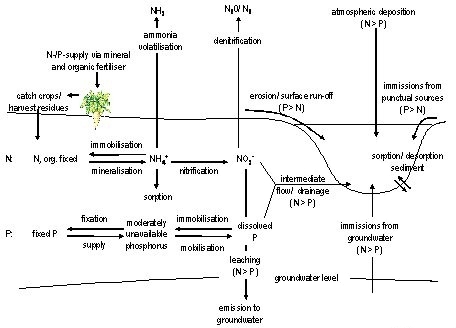Nutrients in Surface Waters
 Biomass production in surface waters is in most cases limited by phosphor supply and in some cases by nitrogen supply. Thus “increased concentrations of N and P in surface waters promote eutrophication causing a direct impact on aquatic ecology” (Gregory et al. 2002).
Biomass production in surface waters is in most cases limited by phosphor supply and in some cases by nitrogen supply. Thus “increased concentrations of N and P in surface waters promote eutrophication causing a direct impact on aquatic ecology” (Gregory et al. 2002).
Agriculture is one of the key polluters that contribute to N and P emissions to surface waters mainly via surface runoff and drainage waters from arable land.
To assess different production practices regarding their potential for N and P emissions to surface waters four parameters were introduced:
- N-balance after harvest
- Total fertiliser-N
- P-balance after harvest
- Total fertiliser-P
All alternative production practices of all crops defined for the model were rated by their goal achievement levels using a fuzzy tool with the optimum goal being minimum N and P emissions.
Consequently the set aside option is best rated because no fertiliser is applied to the plots. In average with a wide range of variation cereals are rated good (> 0,7). Moderate to poor ratings were given for sugar beets, maize for silage, potatoes and winter oilseed rape. Also grassland for hay or silage is rated as moderate because of the fertilization practices used which have a high potential for phosphorus losses.

 Previous:
Nitrate Leaching
Previous:
Nitrate Leaching

